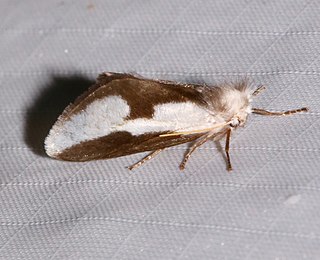Emarginachelys cretacea is a turtle belonging to the group Cryptodira, known from well preserved fossils from the Maastrichtian stage of the Late Cretaceous of Montana. Its exact phylogenetic position within Cryptodira is uncertain; different authors considered it to be either the earliest described chelydrid or a fossil relative of kinosternoids.

Norape is a genus of moths in the family Megalopygidae. The genus was erected by Francis Walker in 1855.
Norape albilineata is a moth of the family Megalopygidae. It was described by Walter Hopp in 1927. It is found in Brazil.
Norape acuta is a moth of the family Megalopygidae. It was described by Walter Hopp in 1927. It is found in Costa Rica.
Norape draudti is a moth of the family Megalopygidae. It was described by Walter Hopp in 1927. It is found in Mexico.
Norape pampana is a moth of the family Megalopygidae. It was described by Walter Hopp in 1927. It is found in Argentina.
Norape tosca is a moth of the family Megalopygidae. It was described by Walter Hopp in 1927. It is found in Argentina.
Norape truncata is a moth of the family Megalopygidae. It was described by Walter Hopp in 1927. It is found in Venezuela, Peru and Colombia.
Norape variabilis is a moth of the family Megalopygidae. It was described by Walter Hopp in 1927. It is found in Brazil.
Norape zikaniana is a moth of the family Megalopygidae. It was described by Walter Hopp in 1927. It is found in Brazil.
Norape damana is a moth of the family Megalopygidae. It was described by Walter Hopp in 1930. It is found in Brazil.
Norape plumosa is a moth of the Megalopygidae family. It was described by Arthur Gardiner Butler in 1877. It is found in Costa Rica, Panama and the Amazon region.

Norape virgo is a moth of the Megalopygidae family. It was described by Arthur Gardiner Butler in 1877. It is found from southern Texas and southern Arizona to Colombia.
Norape argyrorrhoea is a moth of the Megalopygidae family. It was described by Jacob Hübner in 1825. It is found in Argentina, Trinidad, Brazil, Guyana, Venezuela, Paraguay, Panama, Costa Rica and Mexico.
Norape cana is a moth of the Megalopygidae family. It was described by Paul Dognin in 1907. It is found in Colombia.
Norape laticosta is a moth of the Megalopygidae family. It was described by Harrison Gray Dyar Jr. in 1910. It is found in Mexico (Guerrero).
Norape puella is a moth of the Megalopygidae family. It was described by Francis Walker in 1855.

Norape tener, the mesquite stinger moth, is a species of moth in the family Megalopygidae. It was described by Herbert Druce in 1897. It is found in Mexico and the south-western US.
Norape vesta is a moth of the Megalopygidae family. It was described by William Schaus in 1892.
Norape xantholopha is a moth of the Megalopygidae family. It was described by Harrison Gray Dyar Jr. in 1914. It is found in Panama, Guatemala, Colombia and Peru.


